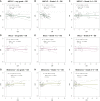Immune-related adverse events as potential surrogates of immune checkpoint inhibitors' efficacy: a systematic review and meta-analysis of randomized studies
- PMID: 36842300
- PMCID: PMC9984799
- DOI: 10.1016/j.esmoop.2023.100787
Immune-related adverse events as potential surrogates of immune checkpoint inhibitors' efficacy: a systematic review and meta-analysis of randomized studies
Abstract
Background: Immune-related adverse events (irAEs) are frequently reported during immune checkpoint inhibitor (ICI) therapy and are associated with long-term outcomes. It is unknown if the irAE occurrence is a valid surrogate of ICIs' efficacy.
Methods: We identified articles reporting the results of randomized trials of experimental ICI therapy in solid tumors with a systematic search. The control arms could be placebo, cytotoxic/targeted therapy, or ICI therapy. We extracted the hazard ratios for overall survival (OS) with the number of OS events per arm and the number and percentages of overall and specific irAEs of grade 1-2 and grade 3-4 per arm. We estimated the treatment effect on the potential surrogate outcome with the odds ratio of the irAE rate between the experimental and the control arm. The statistical analysis consisted of weighted linear regression on a logarithmic scale between treatment effects on irAE rate and treatment effects on OS.
Results: Sixty-two randomized trials were included for a total of 79 contrasts and 42 247 patients. The analyses found no significant association between the treatment effects for overall grade 1-2 or grade 3-4 irAE rates or specific (skin, gastrointestinal, endocrine) irAE rates. In the non-small-cell lung cancer (NSCLC) trial subset, we observed a negative association between treatment effects on overall grade 1-2 irAEs and treatment effects on OS in studies with patients selected for programmed death-ligand 1 expression (R2 = 0.55; 95% confidence interval 0.20-0.95; R = -0.69). In the melanoma trial subset, a negative association was shown between treatment effects on gastrointestinal grade 3-4 irAEs and treatment effects on OS in trials without an ICI-based control arm (R2 = 0.77; 95% confidence interval 0.24-0.99; R = -0.89).
Conclusions: We found low-strength correlations between the ICI therapy effects on overall or specific irAE rates and the treatment effects on OS in several cancer types.
Keywords: immune checkpoint inhibitors; immune-related adverse events; surrogate endpoints; trial-based meta-analysis.
Copyright © 2023 The Authors. Published by Elsevier Ltd.. All rights reserved.
Figures





Similar articles
-
A Network Comparison on Safety Profiling of Immune Checkpoint Inhibitors in Advanced Lung Cancer.Front Immunol. 2021 Dec 3;12:760737. doi: 10.3389/fimmu.2021.760737. eCollection 2021. Front Immunol. 2021. PMID: 34925331 Free PMC article.
-
Neoadjuvant treatment for stage III and IV cutaneous melanoma.Cochrane Database Syst Rev. 2023 Jan 17;1(1):CD012974. doi: 10.1002/14651858.CD012974.pub2. Cochrane Database Syst Rev. 2023. PMID: 36648215 Free PMC article.
-
Immune checkpoint inhibitors in first-line therapies of metastatic or early triple-negative breast cancer: a systematic review and network meta-analysis.Front Endocrinol (Lausanne). 2023 May 9;14:1137464. doi: 10.3389/fendo.2023.1137464. eCollection 2023. Front Endocrinol (Lausanne). 2023. PMID: 37229447 Free PMC article.
-
Nivolumab for adults with Hodgkin's lymphoma (a rapid review using the software RobotReviewer).Cochrane Database Syst Rev. 2018 Jul 12;7(7):CD012556. doi: 10.1002/14651858.CD012556.pub2. Cochrane Database Syst Rev. 2018. PMID: 30001476 Free PMC article.
-
Systemic pharmacological treatments for chronic plaque psoriasis: a network meta-analysis.Cochrane Database Syst Rev. 2017 Dec 22;12(12):CD011535. doi: 10.1002/14651858.CD011535.pub2. Cochrane Database Syst Rev. 2017. Update in: Cochrane Database Syst Rev. 2020 Jan 9;1:CD011535. doi: 10.1002/14651858.CD011535.pub3. PMID: 29271481 Free PMC article. Updated.
Cited by
-
Challenges and Limitations of Endocrine Toxicity Evaluation in Non-Small Cell Lung Cancer Patients Treated with Immunotherapy-Retrospective Study from a Tertiary-Level Hospital in Romania.Diagnostics (Basel). 2023 May 18;13(10):1788. doi: 10.3390/diagnostics13101788. Diagnostics (Basel). 2023. PMID: 37238273 Free PMC article.
-
Immune Checkpoint Inhibitors-Induced Endocrinopathies: Assessment, Management and Monitoring in a Comprehensive Cancer Centre.Endocrinol Diabetes Metab. 2024 Jul;7(4):e00505. doi: 10.1002/edm2.505. Endocrinol Diabetes Metab. 2024. PMID: 38932429 Free PMC article.
-
Effect of glucocorticoids for the management of immune-related adverse events on outcome in melanoma patients treated with immunotherapy-a retrospective and biomarker study.Immunooncol Technol. 2024 May 2;22:100713. doi: 10.1016/j.iotech.2024.100713. eCollection 2024 Jun. Immunooncol Technol. 2024. PMID: 38952418 Free PMC article.
-
Endocrine Immune-Related Adverse Events Are Independent Predictors of Survival in Patients with Lung Cancer.Cancers (Basel). 2024 May 1;16(9):1764. doi: 10.3390/cancers16091764. Cancers (Basel). 2024. PMID: 38730716 Free PMC article.
-
Real-World Evaluation of Immune-Related Endocrinopathies in Metastatic NSCLC Patients Treated with ICIs in Romania.Cancers (Basel). 2025 Mar 31;17(7):1198. doi: 10.3390/cancers17071198. Cancers (Basel). 2025. PMID: 40227797 Free PMC article.
References
-
- Koon H., Atkins M. Autoimmunity and immunotherapy for cancer. N Engl J Med. 2006;354(7):758–760. - PubMed
-
- Zimmer L., Goldinger S.M., Hofmann L., et al. Neurological, respiratory, musculoskeletal, cardiac and ocular side-effects of anti-PD-1 therapy. Eur J Cancer. 2016;60:210–225. - PubMed
-
- Hofmann L., Forschner A., Loquai C., et al. Cutaneous, gastrointestinal, hepatic, endocrine, and renal side-effects of anti-PD-1 therapy. Eur J Cancer. 2016;60:190–209. - PubMed
-
- Boutros C., Tarhini A., Routier E., et al. Safety profiles of anti-CTLA-4 and anti-PD-1 antibodies alone and in combination. Nat Rev Clin Oncol. 2016;13(8):473–486. - PubMed
-
- Haanen J., Carbonnel F., Robert C., et al. Management of toxicities from immunotherapy: ESMO Clinical Practice Guidelines for diagnosis, treatment and follow-up. Ann Oncol. 2018;29(suppl 4):iv264–iv266. - PubMed
Publication types
MeSH terms
Substances
LinkOut - more resources
Full Text Sources
Medical
Research Materials

